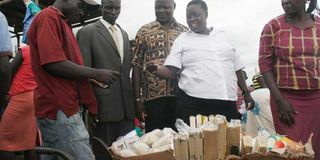Strain on development projects as counties fail to meet revenue average

Kisumu Deputy Governor Ruth Odinga (second right) inspects a receipt issued to traders for revenue collection at Holo Market. A report by the Institute of Economic Affairs reveals that only nine out of the 47 counties surpassed the Sh718 million national average revenue in 2015. FILE PHOTO | NATION MEDIA GROUP
What you need to know:
- The national average revenue is a target set to enable county governments to provide essential services such as health, security and water.
- Nairobi led in revenue generation at Sh11.6 billion, followed by Mombasa, which recorded an impressive Sh2.5 billion in 2015.
- The IEA said that local revenue collection was key to sufficient funding of development projects.
- Marsabit, Kenya’s largest county, collected Sh99 million, Mandera Sh88 million, Lamu, the smallest county, Sh62 million, and Tana River Sh33 million.
- Kisii County collected Sh297 million, Kwale Sh254 million, Baringo Sh250 million, Nyandarua Sh 241million, and Taita-Taveta Sh217 million.
Only nine of the 47 counties surpassed the Sh718 million national average revenue for use in meeting their budgetary needs for 2015.
The national average revenue is money generated to enable county governments to meet demand for essential services such as health, security and water.
The Institute of Economic Affairs (IEA) said this placed a heavy burden on the national government, which had to provide top-ups to enable the counties to pay salaries and allowances as well as operational costs, leaving a small margin for developmental projects.
Figures provided by the IEA on Wednesday show that Nairobi led in revenue generation at Sh 11.6 billion followed by Mombasa, which recorded an impressive Sh2.5 billion in 2015.
The IEA said Nakuru, shy of a city status, came third with Sh2.2 billion.
This was attributed to its strategic location as an agricultural services centre for other counties. It was followed by the industrially rich Kiambu County with Sh2.1 billion.
Tourism continues to support Narok County’s revenue, which now stands at Sh1.6 billion collected in 2015, closely followed by limestone-rich Machakos that boasts six cement factories and hundreds of ongoing construction projects that saw it collect Sh1.5 billion.
Kisumu collected Sh957 million, Uasin Gishu Sh801 million and Kajiado County collected Sh786 million to complete the best nine counties that meet the national average of 718 million.
REVENUE ESSENTIAL FOR DEVELOPMENT
The IEA said that local revenue collection was key to sufficient funding of development projects and expressed the need to encourage the formation of vibrant industrial parks that could spur revenue growth.
“Big cities — Nairobi, Mombasa and Nakuru — generate the highest revenues locally from their established industrial and service sectors, but arid and semi-arid areas like Marsabit, Mandera and Tana River, whose communities are largely pastoralist, generate the lowest nominal amount of revenue,” said the IEA.
Nairobi generates a third of all revenues raised in the counties, giving it the ability to meet most of its budgetary needs, while other counties have to rely on disbursements from the national government to meet operational costs, forcing development to take the backseat.
Nyeri‘s Sh681 million placed it at position 10, Murang’a Sh562 million, Kilifi Sh545 million, Meru Sh539 million, Kakamega Sh517 million, Bungoma Sh505 million, Kericho Sh414 million, Embu Sh401 million and Laikipia Sh400 million.
Migori is Nyanza’s second richest county, with Sh355 million, while Kitui earned Sh320 million, Busia Sh315 million, Kirinyaga Sh312 million and Trans Nzoia Sh301 million to close the best 23 counties.
STANDARDISED SALARIES
While county staff and their assemblies enjoy standardised salaries across the country, 24 counties use their revenues mainly to meet operational costs and have to fill the deficit with inflows from the national government, undermining essential services that would improve the standards of living.
Kisii County collected Sh297 million, Kwale Sh254 million, Baringo Sh250 million, Nyandarua Sh 241million, Taita-Taveta Sh217 million, Makueni Sh215 million, Bomet Sh206 million, Samburu Sh196 million and Nandi Sh193 million.
Homa Bay collected Sh158 million, Siaya Sh143 million, Isiolo Sh134 million and Garissa Sh131 million.
The bottom 10 counties were Elgeyo-Marakwet with Sh129 million, Turkana Sh127 million, Vihiga Sh116 million, Tharaka-Nithi Sh116 million, Wajir Sh108 million, West Pokot Sh104 million and Nyamira Sh104 million.
Marsabit, Kenya’s largest county, collected Sh99 million, Mandera Sh88 million, Lamu, the smallest county, Sh62 million and Tana River Sh33 million.





